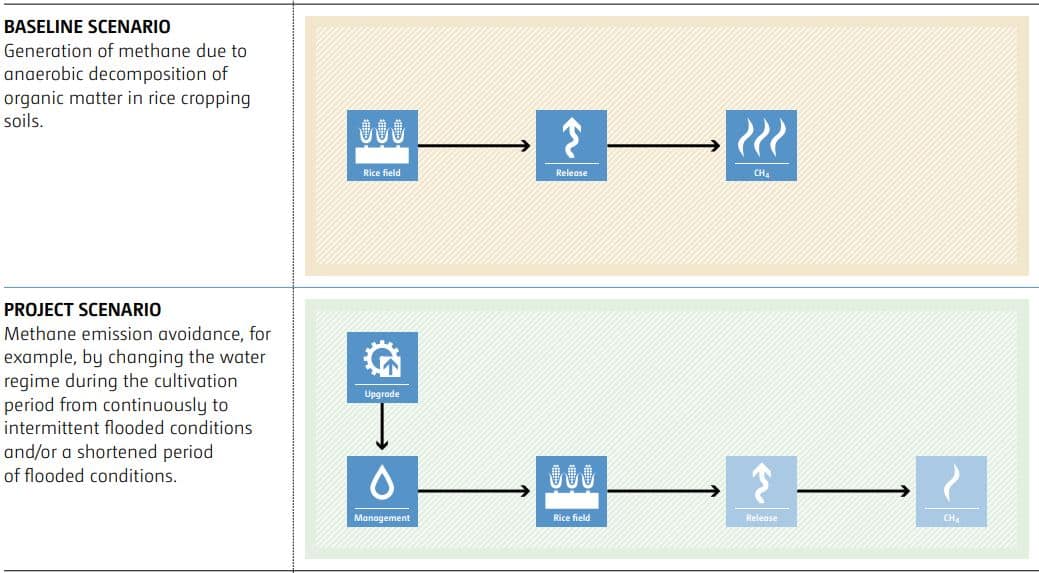World’s largest carbon registry Verra has paused all crediting activities surrounding the use of UNFCCC Clean Development Mechanism (CDM) on rice cultivation methodology.
Verra conducted a review of the use of the CDM methodology AMS-III.AU in its Verified Carbon Standard (VCS) Program. It’s otherwise known as methane emission reduction by adjusted water management practice in rice cultivation.
CDM Rice Cultivation Methodology
The CDM AMS-III.AU applies to reduced anaerobic decomposition of organic matter in rice cropping soils. This includes projects or activities such as the following:
- rice farms that change the water regime during the cultivation period from continuous to intermittent flooded conditions and/or a shortened period of flooded conditions;
- alternate wetting and drying method and aerobic rice cultivation methods; and
- rice farms that change their rice cultivation practice from transplanted to direct seeded rice.
The specific type of climate mitigation action the methodology represents is GHG emission avoidance.
Projects that generate carbon credits under this methodology must meet important conditions. The major one is that rice cultivation in the project area must be characterized by irrigated, flooded fields for an extended period of time during the growing season.
With the project implemented, the rice fields must have a controlled irrigation and drainage system in place. But any activity under the project should not lower rice yield.
Moreover, the project must provide training and technical support to farmers during the cropping season. However, any rice cultivation practice the project introduces should not be subject to local regulation restrictions.
Here’s how it looks like, from baseline scenario to project scenario.
Why Verra Reviews the Methodology
Verra paused the carbon crediting of projects covered by the CDM rice cultivation methodology and placed it under review for these concerns:
- Project categorization as small-scale. This is an important criteria for a project to benefit from UNFCCC CDM rules. Only qualified as such a project can use common practice analysis as part of the additionality tool.
- Potentially not satisfying regulatory surplus requirements or going beyond what the government requires.
- Concerns with project monitoring data quality.
With that said, Verra will immediately inactivate the use of UNFCCC CDM rice cultivation methodology in its VCS Program. And that means suspending all requests involving projects that are using the methodology. These include:
- Pipeline listings
- Registrations
- Verification approvals
- Issuances
The VCS Program allows projects to apply a methodology under other GHG programs such as the UNFCCC CDM. But such an application is still subject to the rules of Verra’s VCS Program.
Rule for Methodology Dev’t and Review Process
The top carbon registry may review methodologies approved under its VCS Program. That is to ensure that they still reflect best practices, scientific consensus, changing market conditions, and technical development in a sector.
Verra is doing a periodic review of each methodology, module, and tool within 5 years after its last review or update. Depending on the result of a review, Verra may revise the methodology.
As per the VCS Program’s rules in Section 5 on methodology development and review process, Verra will conduct the review if a project developer, a VVB, or the registry itself find an issue such as:
- Material inconsistency with a new VCS Program rule (causing material difference in the quantification of GHG emission reductions or removals by projects applying the methodology);
- General scientific or technical developments in a specific sector; or
- Any other well-founded concerns about a methodology.
To date, Verra has registered 37 projects using the CDM rice cultivation methodology. 25 of them have issued verified carbon units or carbon credits amounting to 4.56 million. That figure accounts for only 0.43% of all carbon credits issued and verified by Verra.
The review follows Verra’s initial assessment of concerns raised relating to the methodology. Results will be published as they become available.


